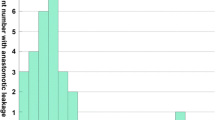Abstract
Purpose
The types of anastomotic leakage that develop following rectal cancer surgery and their impact on long-term outcomes are not well documented. This study aimed to compare the clinical characteristics of various types of anastomotic leakage after anterior resection in rectal cancer patients and evaluate their impact on the long-term oncologic outcomes.
Methods
This study analyzed data obtained from 2510 consecutive patients who underwent anterior resection for rectal cancers. Of these patients, 141 (5.6 %) developed anastomotic leakage. Three types of leakage were categorized according to presentation: generalized peritonitis (type I), localized peritonitis (type II), and fistula or chronic sinus (type III). The clinical characteristics and oncologic outcomes were compared.
Results
Type I leakage was the most common (I 44.7 %, n = 63; II 30.5 %, n = 43; III 24.8 %, n = 35). Type III occurred more frequently in women (p = 0.001) and patients with low rectal cancer (p < 0.001). Patients with type II or III leakage more frequently underwent radiation therapy (p < 0.001) and diverting ostomy (p < 0.001). Leakage management differed according to the type of leakage (p < 0.001). The local recurrence-free survival rate was significantly lower in patients with type II and III leakage (p = 0.014).
Conclusions
The clinical characteristics and oncologic results are distinct for each type of anastomotic leakage. Only a type II or III leakage increases the risk of local recurrence. Each type of leakage should thus be considered a different disease entity.


Similar content being viewed by others
References
Heald RJ (1995) Total mesorectal excision is optimal surgery for rectal cancer: a Scandinavian consensus. Br J Surg 82:1297–1299
Alves A, Panis Y, Trancart D, Regimbeau JM, Pocard M, Valleur P (2002) Factors associated with clinically significant anastomotic leakage after large bowel resection: multivariate analysis of 707 patients. World J Surg 26:499–502
Peeters KC, Tollenaar RA, Marijnen CA, Klein Kranenbarg E, Steup WH, Wiggers T, Dutch Colorectal Cancer Group et al (2005) Risk factors for anastomotic failure after total mesorectal excision of rectal cancer. Br J Surg 92:211–216
Merkel S, Wang WY, Schmidt O, Dworak O, Wittekind C, Hohenberger W et al (2001) Locoregional recurrence in patients with anastomotic leakage after anterior resection for rectal carcinoma. Colorectal Dis 3:154–160
Bell SW, Walker KG, Rickard MJ, Sinclair G, Dent OF, Chapuis PH et al (2003) Anastomotic leakage after curative anterior resection results in a higher prevalence of local recurrence. Br J Surg 90:1261–1266
Ptok H, Marusch F, Meyer F, Schubert D, Gastinger I, Lippert H, Study Group Colon/Rectum Carcinoma (Primary Tumour) (2007) Impact of anastomotic leakage on oncological outcome after rectal cancer resection. Br J Surg 94:1548–1554
Jung SH, Yu CS, Choi PW, Kim DD, Park IJ, Kim HC et al (2008) Risk factors and oncologic impact of anastomotic leakage after rectal cancer surgery. Dis Colon Rectum 51:902–908
den Dulk M, Marijnen CA, Collette L, Putter H, Påhlman L, Folkesson J et al (2009) Multicentre analysis of oncological and survival outcomes following anastomotic leakage after rectal cancer surgery. Br J Surg 96:1066–1075
Bertelsen CA, Andreasen AH, Jørgensen T, Harling H, Danish Colorectal Cancer Group (2010) Anastomotic leakage after curative anterior resection for rectal cancer: short and long-term outcome. Colorectal Dis 12:e76–e81
Jörgren F, Johansson R, Damber L, Lindmark G (2011) Anastomotic leakage after surgery for rectal cancer: a risk factor for local recurrence, distant metastasis and reduced cancer-specific survival? Colorectal Dis 13:272–283
Smith JD, Paty PB, Guillem JG, Temple LK, Weiser MR, Nash GM (2012) Anastomotic leak is not associated with oncologic outcome in patients undergoing low anterior resection for rectal cancer. Ann Surg 256:1034–1038
Rahbari NN, Weitz J, Hohenberger W, Heald RJ, Moran B, Ulrich A et al (2010) Definition and grading of anastomotic leakage following anterior resection of the rectum: a proposal by the International Study Group of Rectal Cancer. Surgery 147:339–351
Chambers WM, Mortensen NJ (2004) Postoperative leakage and abscess formation after colorectal surgery. Best Pract Res Clin Gastroenterol 18:865–880
Montedori A, Cirocchi R, Farinella E, Sciannameo F, Abraha I (2010) Covering ileo- or colostomy in anterior resection for rectal carcinoma. Cochrane Database Syst Rev 12, CD006878
Morgenstern L, Sanders G, Wahlstrom E, Yadegar J, Amodeo P (1984) Effect of preoperative irradiation on healing of low colorectal anastomoses. Am J Surg 147:246–249
Matthiessen P, Hansson L, Sjödahl R, Rutegård J (2010) Anastomotic-vaginal fistula (AVF) after anterior resection of the rectum for cancer-occurrence and risk factors. Colorectal Dis 12:351–357
Fermor B, Umpleby HC, Lever JV, Symes MO, Williamson RC (1986) Proliferative and metastatic potential of exfoliated colorectal cancer cells. J Natl Cancer Inst 76:347–349
McMillan DC, Canna K, McArdle CS (2003) Systemic inflammatory response predicts survival following curative resection of colorectal cancer. Br J Surg 90:215–219
Hanahan D, Weinberg RA (2011) Hallmarks of cancer: the next generation. Cell 144:646–674
Balkwill F, Mantovani A (2001) Inflammation and cancer: back to Virchow? Lancet 357:539–545
Abramovitch R, Marikovsky M, Meir G, Neeman M (1999) Stimulation of tumour growth by wound-derived growth factors. Br J Cancer 79:1392–1398
François A, Milliat F, Guipaud O, Benderitter M (2013) Inflammation and immunity in radiation damage to the gut mucosa. Biomed Res Int 2013:123241
Ong ZY, Gibson RJ, Bowen JM, Stringer AM, Darby JM, Logan RM et al (2010) Pro-inflammatory cytokines play a key role in the development of radiotherapy-induced gastrointestinal mucositis. Radiat Oncol 5:22
Conflicts of interest and funding sources
None to declare.
Author information
Authors and Affiliations
Corresponding author
Rights and permissions
About this article
Cite this article
Lim, SB., Yu, C.S., Kim, C.W. et al. The types of anastomotic leakage that develop following anterior resection for rectal cancer demonstrate distinct characteristics and oncologic outcomes. Int J Colorectal Dis 30, 1533–1540 (2015). https://doi.org/10.1007/s00384-015-2359-7
Accepted:
Published:
Issue Date:
DOI: https://doi.org/10.1007/s00384-015-2359-7




